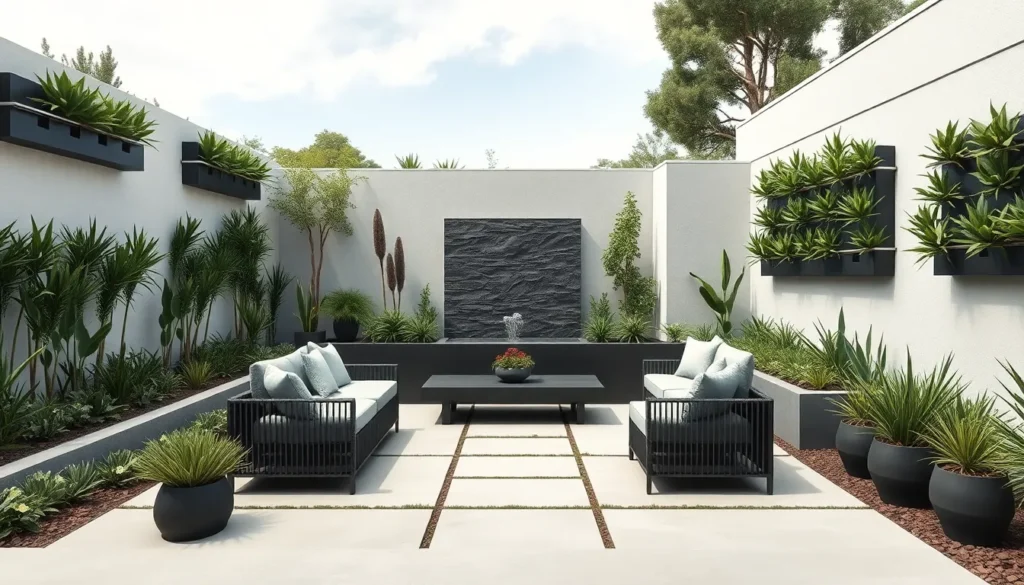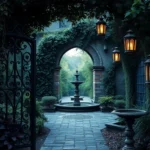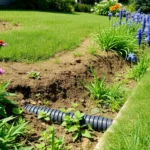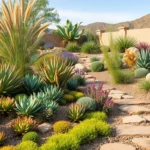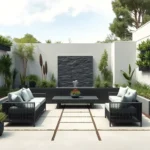We’ve all dreamed of transforming our outdoor spaces into stunning contemporary retreats that reflect modern living. Today’s garden design trends blend functionality with aesthetic appeal creating spaces that serve as natural extensions of our homes. Whether you’re working with a sprawling backyard or a compact urban plot contemporary garden ideas offer endless possibilities for creating your perfect outdoor sanctuary.
The beauty of contemporary garden design lies in its emphasis on clean lines minimalist elements and sustainable practices. We’re seeing homeowners embrace everything from vertical gardens and outdoor living rooms to drought-resistant plant selections and smart irrigation systems. These modern approaches not only create visually striking landscapes but also address practical concerns like water conservation and low maintenance requirements.
Ready to discover how contemporary garden ideas can revolutionize your outdoor space? We’ll explore the most innovative trends techniques and design principles that’ll help you create a garden that’s both stylish and functional for years to come.
Modern Minimalist Garden Designs That Embrace Clean Lines
We find that contemporary garden spaces thrive when excess elements are stripped away to reveal essential beauty. Modern minimalist designs create sophisticated outdoor environments through intentional simplicity and purposeful restraint.
Geometric Plant Arrangements and Structured Layouts
Geometric arrangements transform outdoor spaces into living architectural statements. We organize plants in rectangular beds, circular planters, and triangular formations to create visual harmony throughout the garden. Square raised beds filled with ornamental grasses like fountain grass or feather reed grass establish strong foundational patterns.
Structured layouts emphasize repetition and symmetry for maximum impact. We position identical plantings at regular intervals along pathways or property borders. Row plantings of boxwood hedges, lavender bushes, or ornamental cabbage create rhythmic patterns that guide the eye through outdoor spaces.
Grid systems organize diverse plant materials into cohesive design frameworks. We divide garden areas into uniform sections and fill each space with single plant varieties. This approach works particularly well with succulents like agave, sedum, or echeveria arranged in checkerboard patterns.
Monochromatic Color Schemes for Visual Impact
Monochromatic palettes create sophisticated visual depth without overwhelming complexity. We select plants within single color families to establish calm, unified outdoor environments. White gardens featuring jasmine, gardenia, and white roses provide elegant evening ambiance through their luminous blooms.
Green focused designs showcase texture and form over colorful distractions. We combine different shades and textures of green foliage to create ever-changing interest. Hostas, ferns, and moss create layered green compositions that remain visually captivating throughout growing seasons.
Silver and gray plant combinations deliver contemporary sophistication. We incorporate lamb’s ear, dusty miller, and artemisia to establish cool, modern color schemes. These plants complement concrete surfaces, steel planters, and stone pathways commonly found in minimalist garden designs.
Sculptural Elements as Focal Points
Sculptural elements anchor minimalist gardens with purposeful artistic statements. We position geometric sculptures, abstract metal forms, or contemporary stone pieces as central design features. Single large sculptures work more effectively than multiple smaller pieces in maintaining clean aesthetic principles.
Water features serve dual functions as sculptures and sound elements. We install geometric fountains, linear water walls, or circular reflecting pools to add movement and auditory interest. Rectangular water features with clean edges complement the structured layouts typical of minimalist garden designs.
Architectural plants function as living sculptures within outdoor spaces. We select specimens with strong structural forms like yucca, agave, or Japanese maple to create natural focal points. These plants maintain their sculptural qualities year round while requiring minimal maintenance to preserve their distinctive shapes.
Sustainable Contemporary Garden Ideas for Eco-Conscious Homeowners
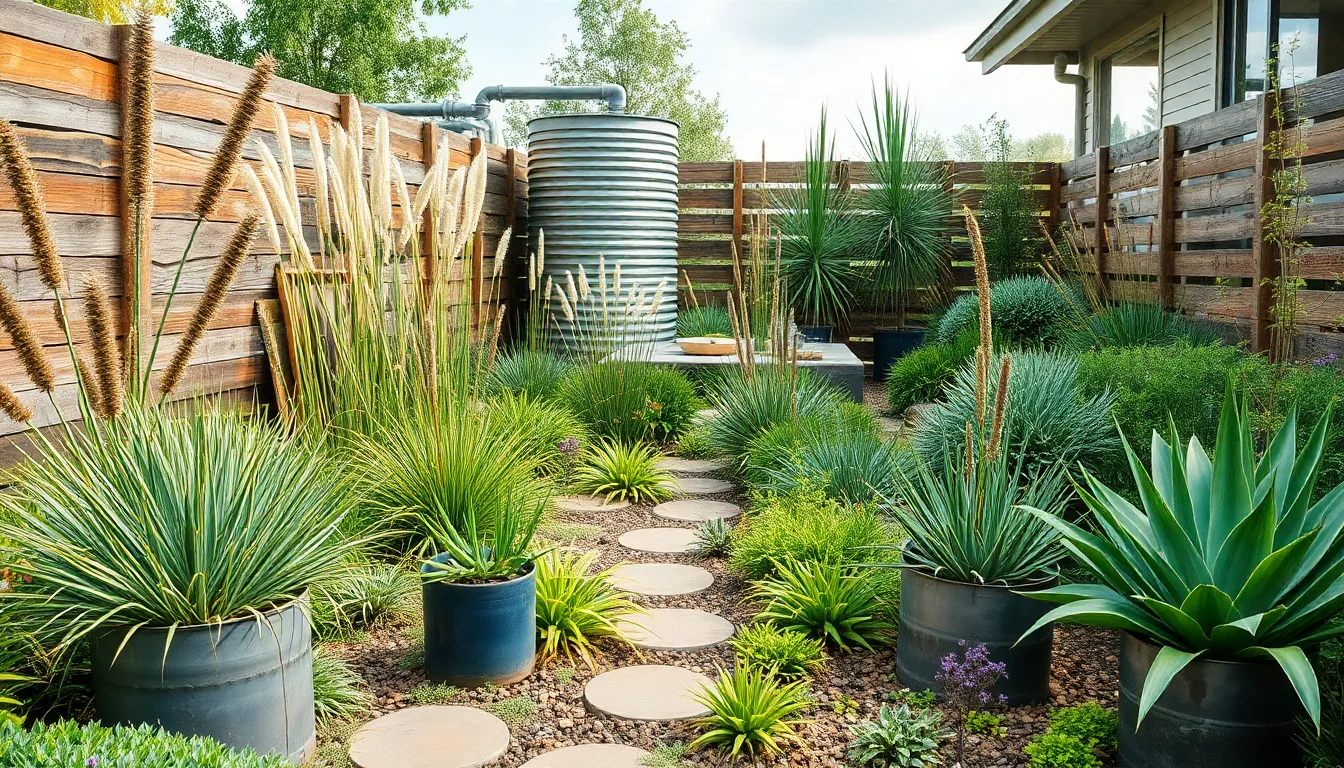
Building on these clean and modern design principles, we can enhance our gardens’ environmental impact through sustainable practices that complement contemporary aesthetics.
Native Plant Integration and Xeriscaping Techniques
Native plants form the foundation of sustainable contemporary gardens because they’re naturally adapted to local climates and require minimal intervention. We recommend incorporating species that thrive in your region’s natural conditions, reducing the need for fertilizers, pesticides, and excessive watering. Xeriscaping techniques complement this approach by emphasizing drought-tolerant varieties that create water-efficient landscapes without sacrificing visual appeal.
Contemporary gardens benefit from the naturally matured appearance that native plantings provide, aligning with 2025’s trend toward authentic, lived-in outdoor spaces. Drought-resistant plants like ornamental grasses, succulents, and native wildflowers offer sculptural qualities that enhance modern design while supporting local biodiversity. Strategic placement of these plants creates texture and seasonal interest that evolves naturally throughout the year.
Rainwater Harvesting and Smart Irrigation Systems
Rainwater collection systems integrate seamlessly into contemporary garden designs while dramatically reducing our reliance on municipal water sources. We can install sleek rain barrels, underground cisterns, or decorative water collection features that capture and store precipitation for later use. Modern collection systems often feature clean lines and materials that complement contemporary architecture.
Smart irrigation technology automates watering schedules based on soil moisture levels, weather forecasts, and plant-exact needs. These systems optimize water usage by delivering precise amounts directly to root zones, preventing waste while maintaining garden health. Integration with smartphone apps allows us to monitor and adjust watering remotely, ensuring our gardens receive appropriate care even when we’re away.
Recycled Materials and Upcycled Garden Features
Reclaimed materials add character and sustainability to contemporary garden spaces through creative repurposing of existing resources. We can incorporate salvaged wood for pathway edging, repurposed metal containers for elevated planters, or recycled concrete for modern hardscaping elements. These materials contribute to the authentic layered look that defines 2025’s garden aesthetic while reducing environmental waste.
Upcycled features like converted shipping containers for garden storage, repurposed industrial elements as sculptural accents, or salvaged stone for water features create unique focal points. Creative reuse of materials adds texture and history to our gardens while supporting circular economy principles that minimize resource consumption.
Technology-Enhanced Garden Spaces for Modern Living
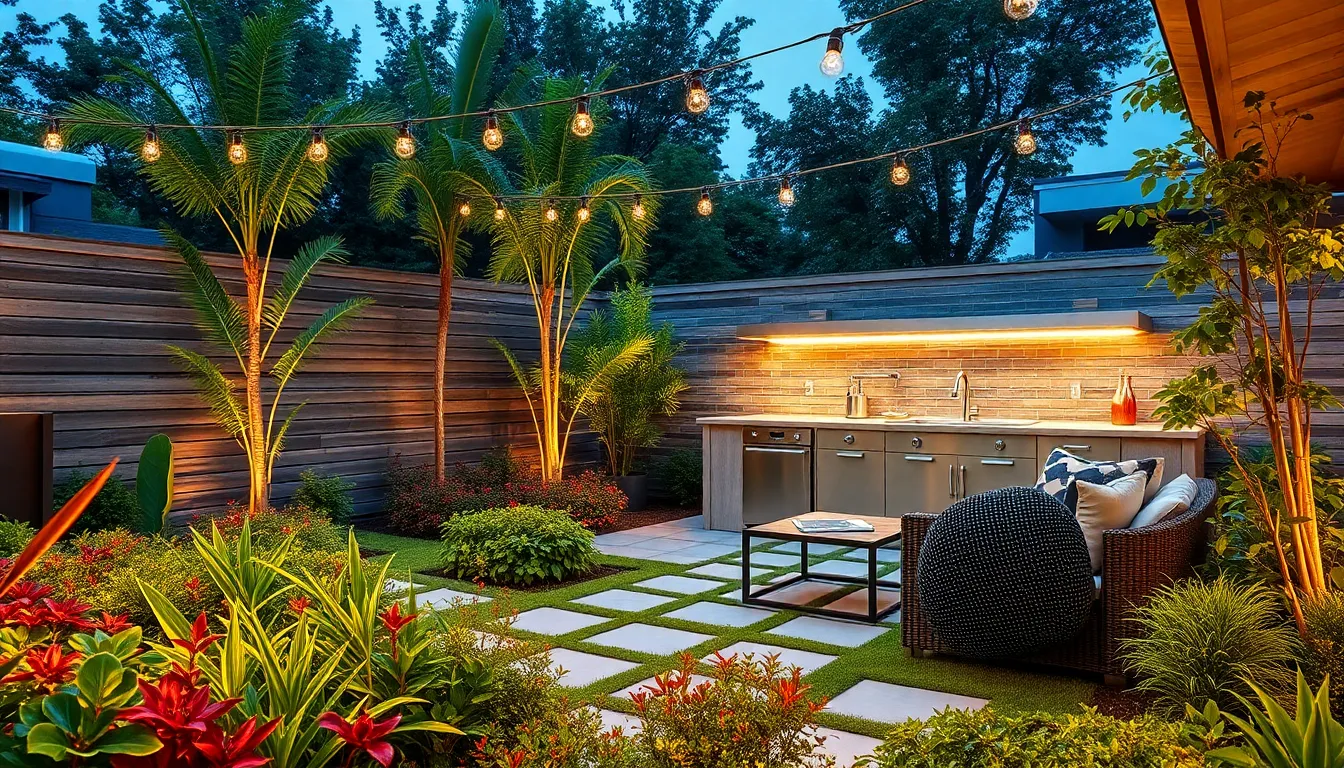
Contemporary gardens now seamlessly blend cutting-edge technology with natural beauty to create sophisticated outdoor environments. We’re witnessing a transformation where smart systems enhance convenience while supporting sustainable practices.
Smart Lighting Systems and Automated Controls
Smart LED lighting systems revolutionize how we illuminate our outdoor spaces with programmable features that adjust brightness, color, and scheduling remotely. These systems connect to our smartphones and tablets, allowing us to create custom lighting scenes for different occasions like dinner parties, quiet evenings, or security purposes.
Automated controls reduce energy consumption by 30-40% compared to traditional lighting setups while improving both safety and aesthetic appeal during nighttime hours. Motion sensors activate pathway lighting automatically, while timer functions ensure lights turn on at sunset and off at sunrise without manual intervention.
Color-changing capabilities let us transform garden moods instantly, shifting from warm amber tones for relaxation to vibrant colors for celebrations. Weather-resistant fixtures withstand harsh conditions, and many systems integrate with voice assistants for hands-free operation throughout our outdoor living areas.
Outdoor Entertainment Integration
Built-in entertainment components transform gardens into complete outdoor living rooms equipped with weatherproof speakers, outdoor kitchens, and audiovisual setups. We can install Bluetooth-enabled sound systems that blend seamlessly into industry designs, often disguised as decorative rocks or planters.
Outdoor kitchens feature smart appliances including Wi-Fi connected grills, refrigerators, and pizza ovens that we control through mobile apps. These cooking stations integrate natural materials like stone and wood to maintain aesthetic harmony with surrounding plantings and hardscaping elements.
Projection systems create outdoor movie theaters using retractable screens or white garden walls as viewing surfaces. Weatherproof televisions and streaming devices provide entertainment options during gatherings, while wireless charging stations built into seating areas keep our devices powered throughout extended outdoor sessions.
App-Controlled Irrigation and Monitoring
Smartphone-connected irrigation systems monitor soil moisture levels, weather forecasts, and plant water requirements to optimize watering schedules automatically. These smart controllers prevent overwatering by analyzing real-time data from sensors placed throughout garden beds and container plantings.
Weather-based adjustments pause irrigation during rainy periods and increase frequency during heat waves, conserving water while maintaining optimal plant health. We receive notifications about system performance, potential leaks, and maintenance needs directly on our mobile devices.
Soil monitoring sensors track pH levels, nutrient content, and temperature to provide comprehensive growing condition data. Advanced systems integrate with weather services to predict irrigation needs up to seven days in advance, supporting healthier plant growth while reducing water waste by up to 50% compared to traditional sprinkler systems.
Contemporary Vertical Garden Solutions for Small Spaces
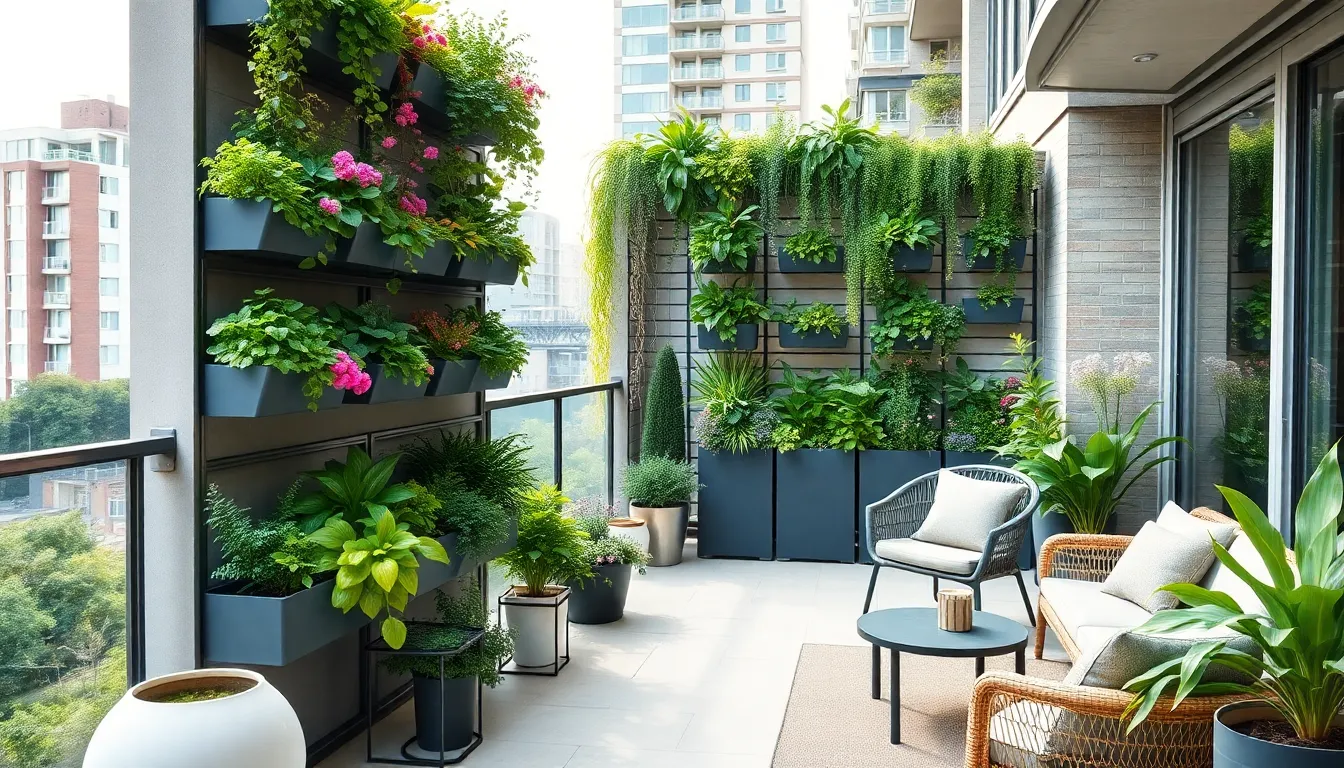
Vertical gardening transforms limited outdoor areas into lush green sanctuaries that maximize every square foot. We’re seeing innovative approaches that bring nature indoors and outdoors through creative vertical installations.
Living Wall Systems and Green Architecture
Living wall systems revolutionize how we approach gardening in compact spaces by utilizing vertical surfaces as planting opportunities. We attach plants directly to walls using specialized trellises, frames, and support structures that create stunning botanical displays. These systems work particularly well for apartment dwellers and urban homeowners who lack traditional garden space.
Green architecture takes this concept further by integrating vegetation into building design itself. We’re incorporating green roofs and living walls that serve multiple purposes beyond aesthetics. These installations improve air quality significantly while providing natural insulation that reduces energy costs. Urban ecosystems benefit tremendously from these architectural elements as they create habitat corridors for wildlife and help manage stormwater runoff.
Wall mounted planters offer flexibility for renters who can’t make permanent installations. We recommend selecting lightweight materials that won’t damage existing structures while providing adequate drainage for plant health.
Modular Planting Systems and Space Optimization
Modular systems provide unmatched flexibility through interlocking planters and tiered designs that adapt to changing needs. We can easily rearrange these components to accommodate different plant species or create seasonal displays that keep our gardens looking fresh year round. Balconies and rooftops benefit especially from these adaptable answers.
Tiered designs maximize growing space by creating multiple planting levels within the same footprint. We stack containers at varying heights to ensure each plant receives adequate sunlight while creating visual depth. These systems work exceptionally well for herb gardens where we need easy access to frequently harvested plants.
Space optimization becomes critical in urban environments where every inch matters. We position larger plants at the back of tiered systems and cascade smaller varieties forward to create natural looking arrangements that don’t feel cramped or artificial.
Urban Balcony and Rooftop Garden Transformations
Vertical planting transforms bare balcony walls into productive growing spaces using wall mounted planters and climbing trellises. We create lush environments that provide privacy screening while producing fresh herbs and vegetables. Strategic placement ensures plants receive optimal sunlight without overwhelming the limited floor space.
Container gardening offers versatility for both balconies and rooftops through large pots and planters that accommodate diverse plant selections. We choose containers that complement our overall design aesthetic while providing adequate root space for healthy plant development. Weather resistant materials ensure longevity in challenging urban conditions.
Seating areas and strategic lighting enhance the usability of urban gardens by creating inviting spaces for relaxation and entertainment. We integrate comfortable seating that doubles as storage for gardening tools and supplies. LED lighting systems extend garden enjoyment into evening hours while highlighting our vertical installations’ architectural beauty.
| Urban Garden Feature | Space Efficiency | Maintenance Level | Cost Range |
|---|---|---|---|
| Living Wall Systems | High | Medium | $200-$800 |
| Modular Planters | Very High | Low | $50-$300 |
| Container Gardens | Medium | Low | $100-$500 |
| Integrated Seating | High | Very Low | $150-$600 |
Stylish Outdoor Room Concepts That Blur Indoor-Outdoor Boundaries
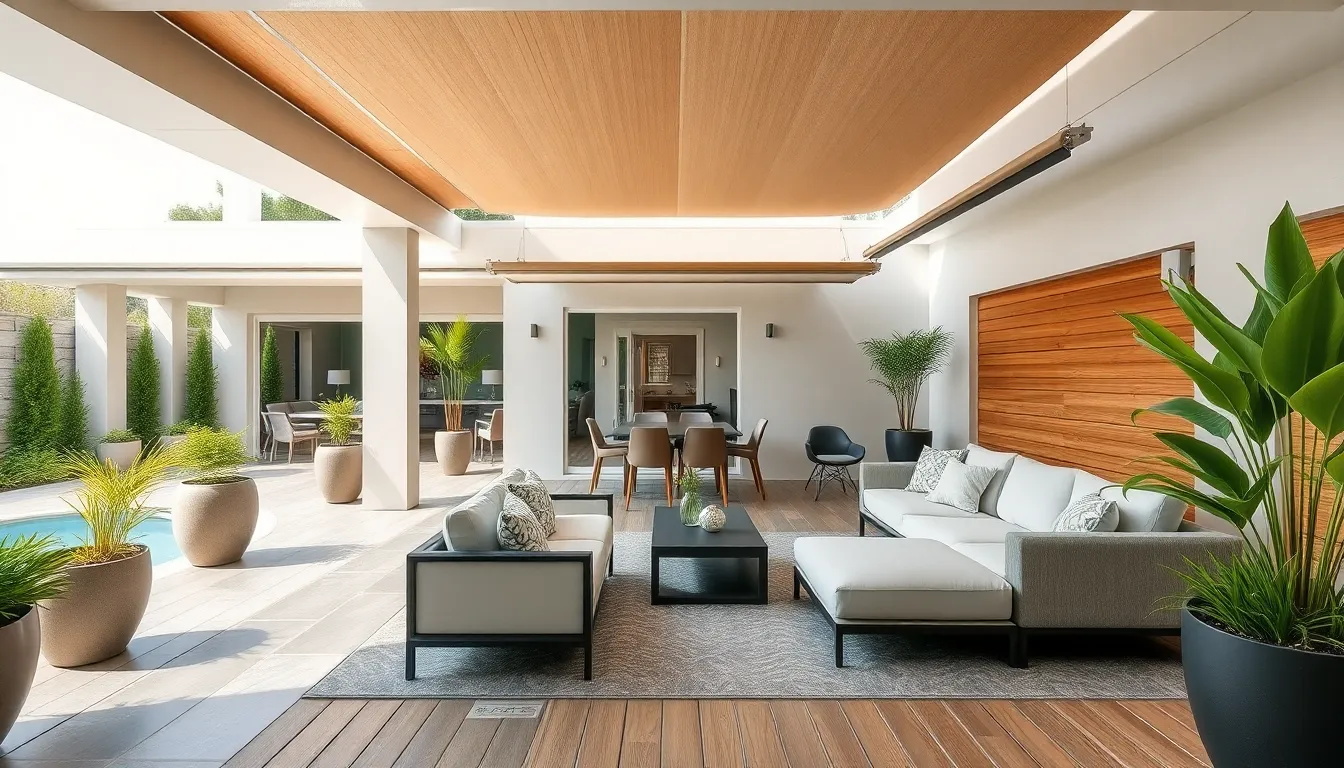
Contemporary garden designs transform outdoor spaces into functional living areas that seamlessly extend our homes beyond traditional walls. These innovative concepts create cohesive environments where indoor comfort meets outdoor freedom.
Seamless Flooring Transitions and Material Continuity
Stone, wood, and porcelain materials create uninterrupted visual flow from interior spaces to garden areas. We achieve this continuity by selecting flooring options that withstand weather conditions while maintaining consistent aesthetics throughout both environments.
Threshold free design eliminates traditional barriers between indoor and outdoor spaces, making transitions feel natural and effortless. Large format tiles, composite decking, and natural stone slabs work particularly well for this application.
Material coordination ensures color palettes and textures complement existing interior finishes. We recommend matching undertones rather than exact colors to create sophisticated connections that feel intentional rather than forced.
Installation techniques like floating floors and interlocking systems allow materials to expand and contract with temperature changes while maintaining their appearance. Professional installation becomes crucial for achieving the seamless look that defines contemporary outdoor rooms.
Weather-Resistant Furniture and Modern Accessories
Recycled plastic, teak, and stainless steel materials provide durability without sacrificing style in contemporary outdoor settings. These materials resist fading, cracking, and corrosion while maintaining their sleek appearance through multiple seasons.
Modern accessories like solar powered lights, outdoor heaters, and stylish planters enhance both functionality and aesthetic appeal. We select pieces that complement the clean lines and minimalist principles established in previous design elements.
Modular furniture systems offer flexibility for different activities and weather conditions. Sectional seating, expandable dining tables, and stackable chairs allow us to reconfigure spaces based on seasonal needs or entertainment requirements.
Protective covers and storage answers extend furniture lifespan while maintaining the polished appearance of outdoor rooms. Built in storage benches and weatherproof cushion boxes keep accessories organized and protected.
Climate Control Features for Year-Round Use
Retractable awnings and umbrellas provide adjustable shade answers that adapt to changing sun patterns throughout the day. These systems offer protection from both harsh sunlight and light precipitation while preserving open sky views when desired.
Outdoor heaters and fans extend the usability of garden rooms across different seasons and temperature conditions. Electric patio heaters, fire tables, and ceiling fans create comfortable microclimates for year round enjoyment.
Glass walls and insulated pergolas maintain comfortable temperatures while providing weather protection. These architectural elements allow us to enjoy outdoor views and fresh air circulation while controlling environmental conditions.
Smart climate systems integrate with home automation to automatically adjust heating, cooling, and shading based on weather conditions and occupancy patterns. Motion sensors, temperature controls, and weather monitoring create responsive environments that enhance comfort and energy efficiency.
Contemporary Water Features That Create Tranquil Focal Points
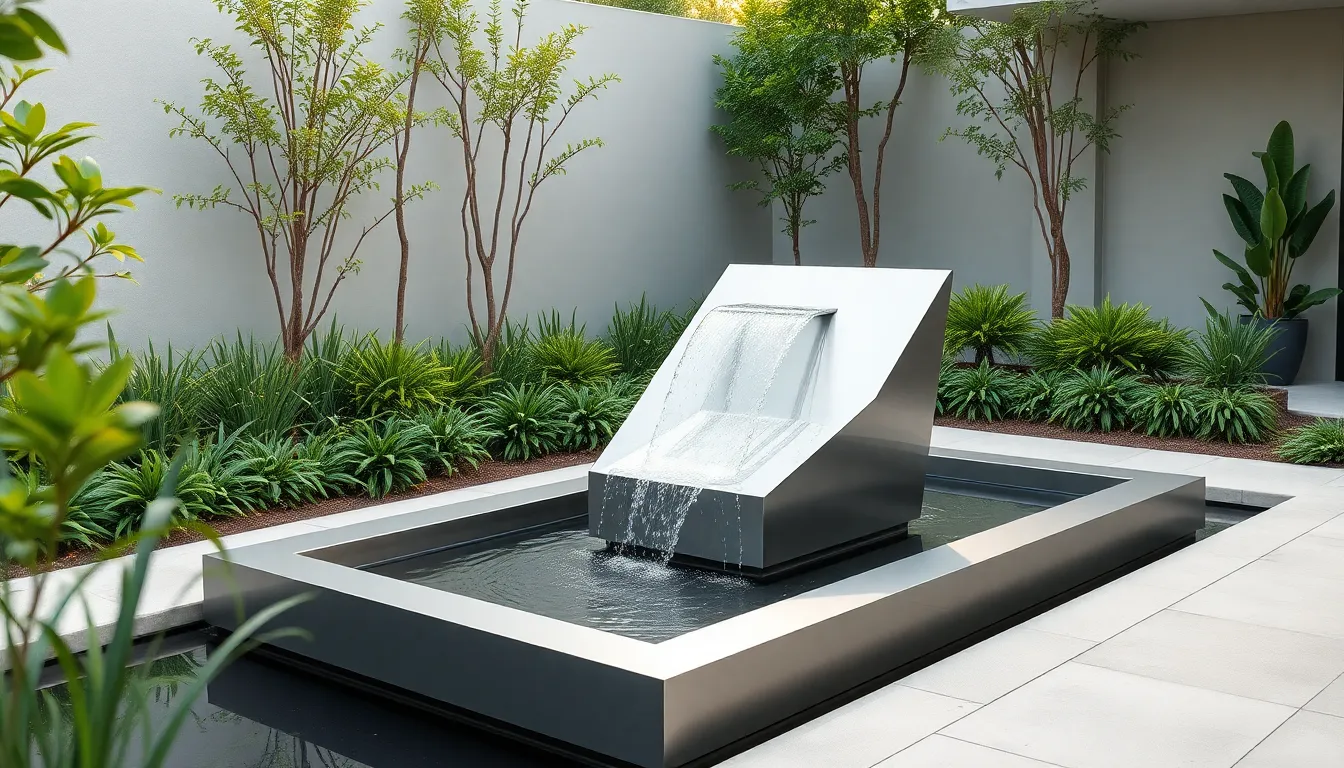
Water elements transform modern gardens into serene environments while serving as striking architectural focal points. These features seamlessly integrate with technology driven outdoor spaces to create harmonious retreats.
Sleek Fountain Designs and Reflecting Pools
Sleek fountain designs anchor contemporary gardens with their modern shapes and premium materials. We see geometric fountains crafted from stainless steel, concrete, and black granite creating dramatic vertical elements that complement minimalist landscaping. Wall mounted fountains maximize space efficiency while delivering the same visual impact as larger installations.
Reflecting pools add serenity and visual appeal to gardens by mirroring surrounding vegetation and architectural elements. These shallow water features create stunning optical illusions that double the perceived garden space. Mirror like surfaces capture changing light throughout the day, transforming from brilliant reflections during sunrise to soft glowing pools at dusk.
Strategic placement near outdoor seating areas enhances relaxation while the gentle sound of trickling water masks urban noise pollution. Contemporary pools often feature LED lighting systems that illuminate the water from below, creating enchanting evening atmospheres that extend outdoor living hours.
Rill Systems and Linear Water Elements
Rill systems create soothing sounds and visual interest through narrow channels of gently flowing water. These architectural water features guide visitors through garden spaces while connecting different zones with continuous movement. Modern rills incorporate geometric patterns that echo the clean lines found in contemporary hardscaping and furniture selections.
Linear water elements enhance spatial design through long, narrow configurations that complement modern aesthetics. Rectangular channels bordered by natural stone or concrete create structured pathways that organize garden layouts. We recommend integrating these features with smart irrigation systems to maintain consistent water flow while conserving resources.
Contemporary installations often feature multiple water levels that create cascading effects without requiring traditional fountain mechanisms. These tiered systems work particularly well in sloped gardens where gravity naturally powers the water movement, reducing energy consumption while maximizing visual drama.
Modern Pond Concepts with Architectural Edge
Modern pond concepts feature geometric shapes and clean lines that blend seamlessly with contemporary architectural designs. Square, rectangular, and circular ponds replace traditional curved forms to create striking geometric statements. These water features integrate with surrounding structures through material continuity, using matching stone, concrete, or metal finishes.
Contemporary ponds can be integrated with retractable covers and automated filtration systems that maintain water quality year round. Smart monitoring technology tracks pH levels, temperature, and clarity while sending maintenance alerts directly to homeowners’ devices. This technological integration ensures pristine water conditions without constant manual oversight.
Raised pond designs elevate water features to become prominent garden sculptures while improving accessibility for maintenance. These installations often incorporate built in seating areas with weather resistant cushions, creating intimate gathering spaces around the water element. Edge lighting transforms these features into glowing beacons during evening entertainment, seamlessly connecting with broader outdoor lighting schemes.
Innovative Material Combinations in Modern Garden Design
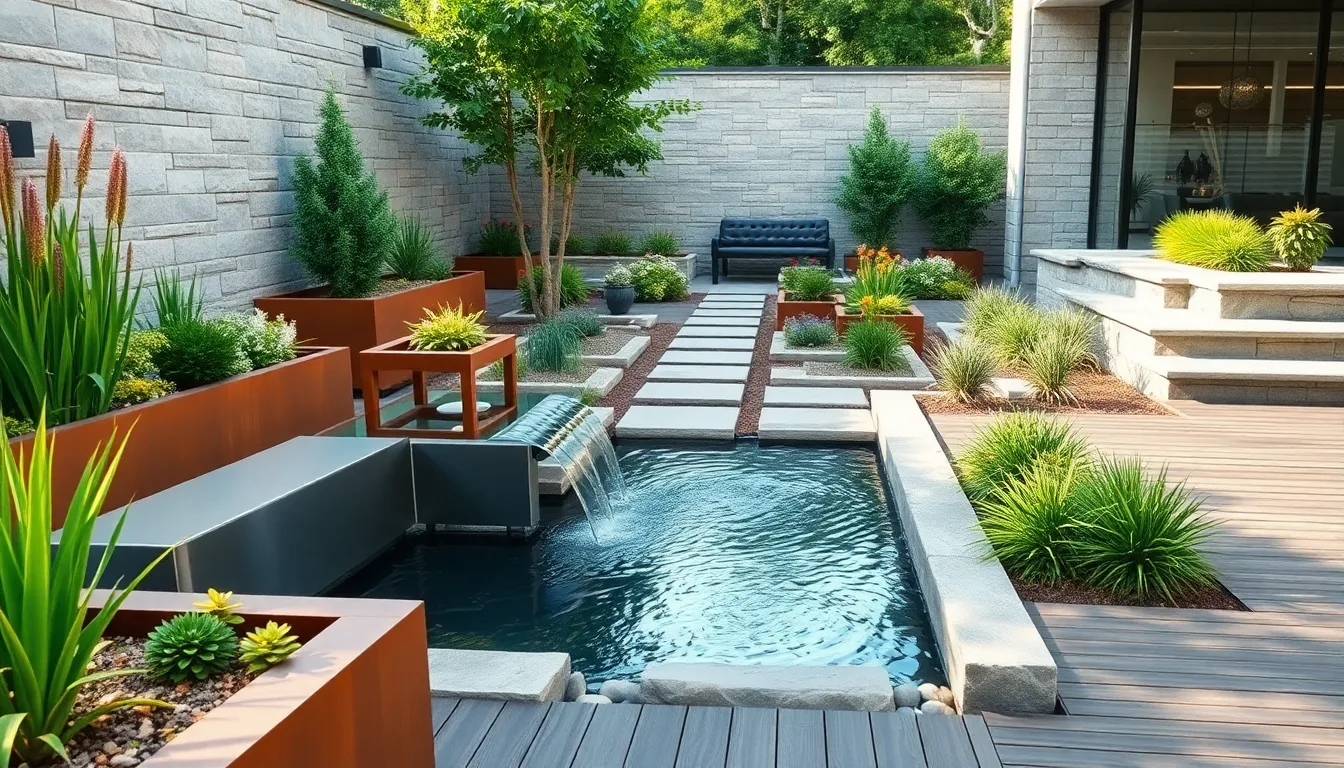
Modern garden design embraces bold material pairings that create striking visual contrasts and enhance outdoor functionality. These innovative combinations transform traditional landscapes into sophisticated contemporary spaces.
Metal and Stone Pairings for Industrial Elegance
Metal and stone pairings deliver an industrial touch that perfectly complements modern garden architecture. Sleek metal elements provide clean lines and contemporary appeal, while natural stone adds warmth and organic texture to balance the design aesthetic.
Corten steel planters paired with limestone retaining walls create stunning focal points that age beautifully over time. The rust-colored patina develops naturally, contrasting magnificently with the stone’s neutral tones.
Stainless steel water features combined with granite or basalt surfaces offer durability and visual impact. These combinations work exceptionally well in minimalist settings where each material’s properties shine without competing for attention.
Powder-coated aluminum screens integrated with sandstone or travertine walls provide privacy while maintaining architectural interest. The metal’s precision manufacturing complements stone’s natural irregularities, creating ever-changing visual tension.
Glass Elements and Transparent Design Features
Glass features introduce openness and transparency that blur boundaries between indoor and outdoor living spaces. Natural light filters through these elements, creating luminous effects that transform throughout the day.
Tempered glass windbreaks protect seating areas while maintaining unobstructed views of the surrounding industry. These installations allow wind protection without sacrificing the open feel that contemporary gardens emphasize.
Glass panel water walls serve as both privacy screens and artistic installations, with water cascading down smooth surfaces to create mesmerizing visual effects. LED lighting behind these features enhances their impact during evening hours.
Transparent planters and containers showcase root systems and soil layers, adding educational and aesthetic value to contemporary gardens. These elements work particularly well with architectural plants that have strong structural forms.
Composite Materials and Low-Maintenance Answers
Composite materials made from recycled plastic and wood fibers are increasingly popular for their durability and reduced maintenance requirements. These answers appeal to busy homeowners seeking beautiful gardens without extensive upkeep demands.
Composite decking systems resist weathering, fading, and insect damage while maintaining the appearance of natural wood. They require no staining or sealing, making them practical choices for contemporary outdoor living spaces.
Engineered bamboo fencing offers sustainability credentials while providing privacy and visual interest. These materials maintain consistent coloring and resist moisture damage better than traditional bamboo installations.
Recycled glass aggregates in concrete pathways and surfaces create unique textures while supporting environmental goals. The glass fragments catch and reflect light, adding sparkle and visual depth to hardscaping elements.
Contemporary Garden Lighting Ideas for Dramatic Evening Appeal
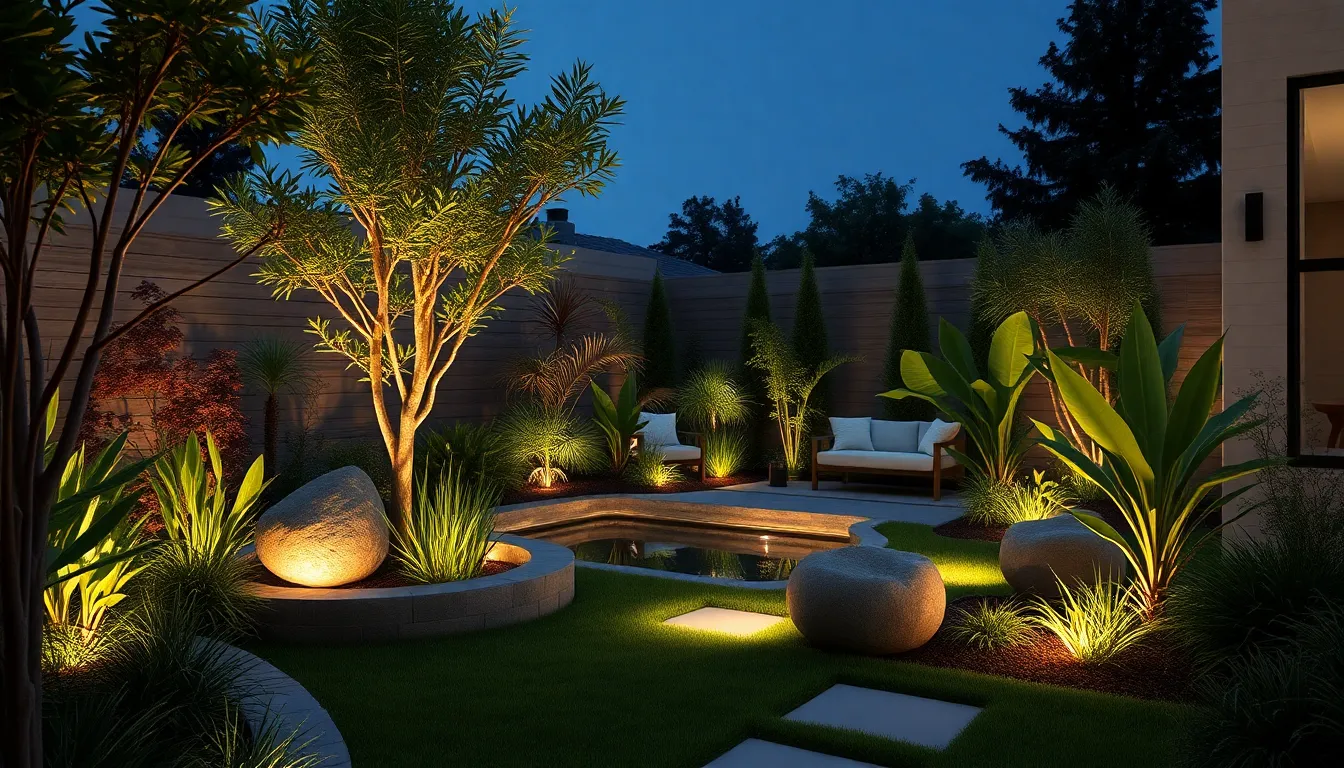
Thoughtful lighting transforms contemporary gardens into captivating evening landscapes that extend our outdoor living experience well beyond daylight hours. Strategic illumination creates depth, highlights architectural features, and establishes ambient moods that complement the sophisticated design elements we’ve established throughout our modern outdoor spaces.
LED Strip Lighting and Accent Illumination
LED strip lighting offers precise control over garden ambiance while maintaining energy efficiency throughout our contemporary landscapes. We can install these flexible strips along pathway edges, underneath built-in seating, or behind water features to create subtle yet impactful illumination that guides movement and highlights key design elements.
Accent illumination using LED technology allows us to emphasize exact garden features like sculptural plants, modern sculptures, or architectural walls with targeted beams. These systems integrate seamlessly with smart home technology, enabling programmable color changes and dimming capabilities that adapt to different occasions and seasonal preferences.
Highlighting water features with strategically placed LED strips creates a vibrant evening ambiance that transforms fountains, ponds, and linear water elements into luminous focal points. The combination of moving water and controlled lighting produces ever-changing visual effects that enhance the tranquil atmosphere of our contemporary gardens.
Solar-Powered Modern Fixtures
Solar-powered fixtures provide sustainable lighting answers that align with the eco-conscious principles of contemporary garden design. Modern solar lights feature sleek profiles and architectural forms that complement minimalist aesthetics while reducing energy consumption and eliminating the need for electrical wiring.
Contemporary solar fixtures now incorporate advanced LED technology and efficient battery systems that deliver reliable illumination throughout the evening hours. We can position these lights along pathways, around seating areas, or as accent pieces within planted areas to create consistent lighting without increasing our environmental footprint.
Wireless installation makes solar lighting particularly valuable for highlighting remote garden areas or creating temporary lighting arrangements for special occasions. The freedom from electrical constraints allows us to experiment with lighting placement and easily relocate fixtures as our garden design evolves.
Industry Uplighting and Shadow Play Techniques
Industry uplighting creates dramatic shadows and emphasizes the vertical elements of our contemporary gardens by positioning lights at ground level to illuminate trees, architectural plants, and structural features from below. This technique adds depth and dimension to evening garden scenes while showcasing the sculptural qualities of carefully selected plants and hardscape elements.
Shadow play techniques involve strategically placing lights to cast interesting patterns and silhouettes onto walls, fences, or neighboring surfaces. We can achieve compelling visual effects by positioning lights behind plants with distinctive foliage or architectural forms, creating ever-changing shadow displays that add movement and interest to static garden elements.
Uplighting garden structures like pergolas, privacy screens, or contemporary sculptures enhances their visual appeal while creating ambient lighting for evening gatherings. The interplay between light and shadow adds complexity to our minimalist designs without cluttering the space with additional decorative elements.
Conclusion
Creating a contemporary garden that reflects modern living doesn’t require starting from scratch or having unlimited space. We’ve shown you how small changes like incorporating vertical elements smart technology and sustainable practices can transform any outdoor area into a sophisticated retreat.
The beauty of contemporary garden design lies in its flexibility and adaptability. Whether you’re working with a sprawling backyard or a compact urban balcony these principles scale to fit your unique situation and lifestyle needs.
Your outdoor space should be an extension of your home – a place where functionality meets beauty and where every element serves a purpose. By combining clean aesthetics with eco-conscious choices you’ll create a garden that’s not only visually stunning but also environmentally responsible and perfectly suited to contemporary living.
Frequently Asked Questions
What are the key elements of contemporary garden design?
Contemporary garden design emphasizes clean lines, minimalist elements, and sustainable practices. Key features include geometric plant arrangements, monochromatic color schemes, drought-resistant plants, vertical gardens, and smart irrigation systems. These designs combine functionality with aesthetic appeal, creating sophisticated outdoor spaces that work for both large backyards and small urban plots.
How can I create a minimalist garden design?
Focus on intentional simplicity and purposeful restraint. Use geometric plant arrangements, structured layouts, and symmetrical plantings organized in grid systems. Adopt monochromatic color schemes like all-white gardens or green-focused designs that emphasize texture over color. Include sculptural elements and architectural plants as focal points while maintaining clean, uncluttered spaces.
What sustainable practices can I incorporate into my modern garden?
Integrate native plants and xeriscaping techniques to reduce water and fertilizer needs. Install rainwater harvesting systems and smart irrigation technology for efficient water management. Use recycled and upcycled materials for garden structures and decorations. These practices support environmental sustainability while creating visually appealing landscapes that require minimal maintenance.
How can technology enhance my garden design?
Smart technology can significantly improve garden convenience and sustainability. Install app-controlled irrigation systems that optimize watering based on real-time data, smart LED lighting with programmable features, and weatherproof outdoor entertainment systems. These technologies reduce water waste, improve energy efficiency, and create more functional outdoor living spaces.
What are vertical garden solutions for small spaces?
Vertical gardens maximize limited outdoor areas through living wall systems, modular planting arrangements, and wall-mounted planters. These solutions are perfect for urban balconies and rooftops, transforming vertical surfaces into lush green sanctuaries. Use tiered designs and container gardening to create productive, aesthetically pleasing environments in small spaces.
How do I create an outdoor room that feels like an indoor extension?
Focus on seamless transitions using weather-resistant materials that match your indoor aesthetic. Install modular furniture systems, retractable awnings, and climate control features like outdoor heaters. Use consistent flooring materials and incorporate smart climate systems to ensure year-round comfort and functionality in your outdoor living space.
What types of water features work best in contemporary gardens?
Modern water features include sleek fountains, geometric reflecting pools, linear rill systems, and contemporary ponds with clean lines. These elements serve as striking architectural focal points while providing soothing sounds and visual interest. Many incorporate smart technology for automated maintenance and enhanced aesthetic appeal.
How can I use innovative materials in my garden design?
Combine contrasting materials for visual impact, such as Corten steel planters with limestone walls or stainless steel features with granite surfaces. Glass elements blur indoor-outdoor boundaries, while composite materials offer low-maintenance solutions. These material combinations create sophisticated, durable designs that enhance both functionality and aesthetic appeal.
What lighting techniques enhance contemporary gardens at night?
Use LED strip lighting and accent illumination to highlight architectural features and create depth. Install solar-powered fixtures for sustainable lighting solutions. Employ uplighting techniques and strategic shadow play to add drama and dimension, showcasing vertical elements and creating interesting visual effects throughout your garden space.

